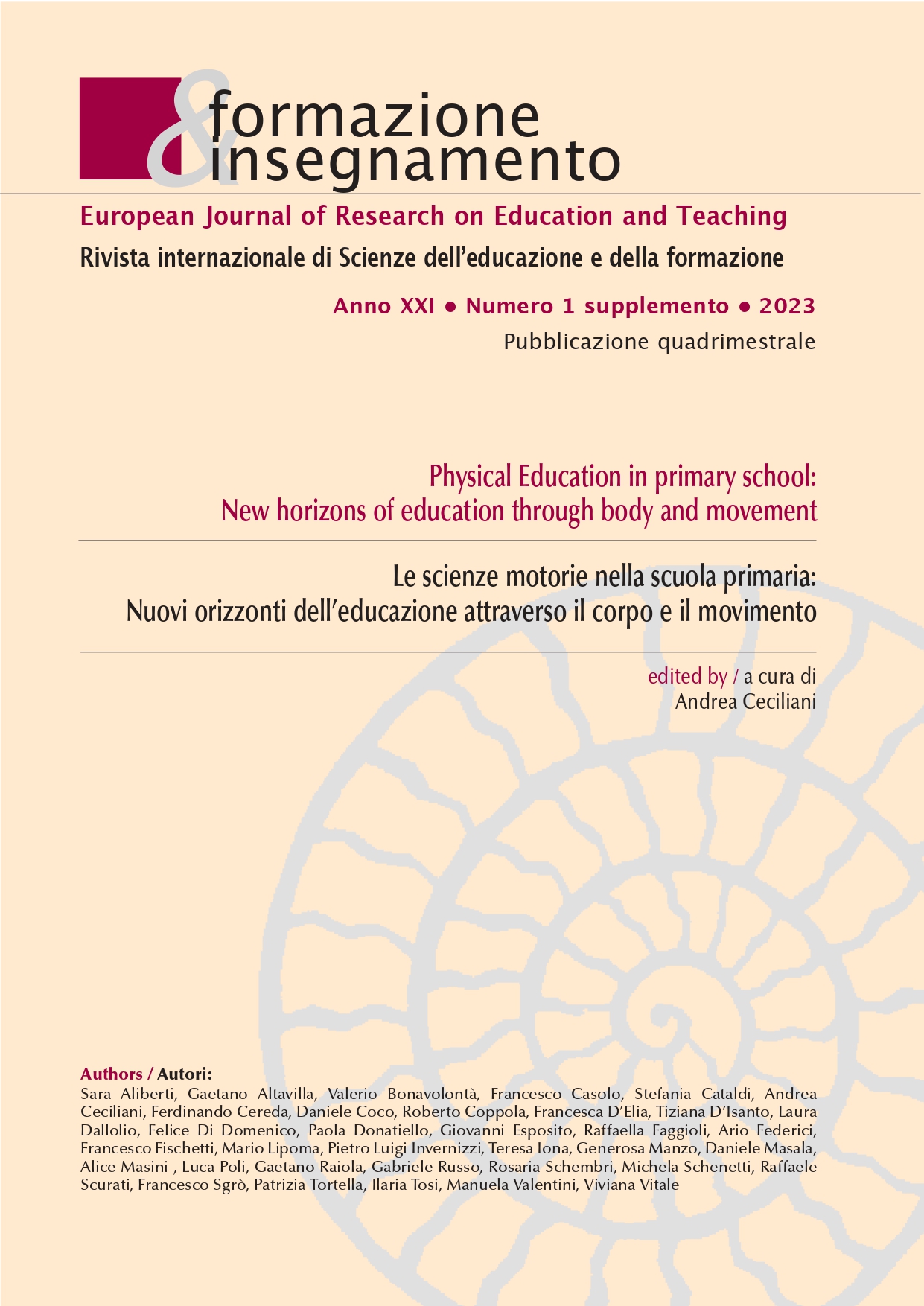Physical Education in primary school: New horizons of education through body and movement
DOI:
https://doi.org/10.7346/-feis-XXI-01-23_01Palabras clave:
Motor science, Primary schoolResumen
After years of work, interrupted by plateaus of political pondering, the 2002 Budget Law (Art. 103) has finally officialized the inclusion of specialist teachers for the subject of Physical Education. That is, after the Italian Senate Bill S 992/2020, which mandated the introduction of specialist teachers to guarantee «a real and qualified teaching for children through interventions that are adequate and targeted in terms of motor development, but also to impact learning, prevention, and socialization» (D’Elia, 2022, p. 82).
Citas
Borgogni, A., & Farinella, R., (2017). Le città attive. Milano: Franco Angeli
Cardon, G., De Clercq, D., De Bourdeaudhuij, I., & Breithecker, D. (2004). Sitting habits in elementary schoolchildren: a traditional versus a “Moving school”. Patient education and counseling, 54(2), 133–142. https://doi.org/10.1016/s0738-3991(03)00215-5
Casolo, F. (2019). L’Educazione Motoria e scuola primaria. Formazione & insegnamento, 17(3), 7–12. https://doi.org/10.7346/-feis-XVII-03-19_01
Ceciliani, A. (2018a). Dall’Embodied Cognition all’Embodied Education nelle scienze dell’attività motoria e sportiva. Encyclopaideia, 22(51), 11–24. https://doi.org/10.6092/issn.1825-8670/8424
Ceciliani, A. (2018b). Didattica integrata quali-quantitativa, in educazione motoria-sportiva, e benessere in età evolutiva. Formazione & insegnamento, 16(1), 183–194. Retrieved January 31, 2022, from https://ojs.pensamultimedia.it/index.php/siref/article/view/2774
Chesham, R. A., Booth, J. N., Sweeney, E. L., Ryde, G. C., Gorely, T., Brooks, N. E., & Moran, C. N. (2018). The Daily Mile makes primary school children more active, less sedentary and improves their fitness and body composition: a quasi-experimental pilot study. BMC medicine, 16(1), 1–13. https://doi.org/10.1186/s12916-018-1049-z
D’Elia, F. (2022) L’educazione motoria nella scuola primaria: analisi e determinazioni. In M. Fiorucci, & E. Zizioli (Eds.), La formazione degli insegnanti: problemi, prospettive e proposte per una scuola di qualità e aperta a tutti e tutte (pp. 82–85). Lecce: Pensa Multimedia
de Bruijn, A. G., Mombarg, R., & Timmermans, A. C. (2022). The importance of satisfying children’s basic psychological needs in primary school physical education for PE-motivation, and its relations with fundamental motor and PE-related skills. Physical Education and Sport Pedagogy, 27(4), 422–439. https://doi.org/10.1080/17408989.2021.1906217
Farné, R., Bortolotti, A., & Terrusi, M. (2018). Outdoor Education: prospettive teoriche e buone pratiche. Roma: Carocci.
Francesconi, D., & Tarozzi, M. (2012). Embodied education: A convergence of phenomenological pedagogy and embodiment. Studia phaenomenologica, 12, 263–288. https://doi.org/10.7761/SP.12.263
Francesconi, D., & Tarozzi, M. (2019). Embodied education and education of the body: The phenomenological perspective. In Leib–Leiblichkeit–Embodiment (pp. 229–247). Weisbaden: Springer.
Immordino-Yang, M. H. (2016). Emotion, sociality, and the brain’s default mode network: Insights for educational practice and policy. Policy Insights from the Behavioral and Brain Sciences, 3(2), 211–219. https://doi.org/10.1177/2372732216656869
Lipoma M. (2014). Le ontologie pedagogiche dell’educazione motoria. In U. Margiotta (Ed.), Qualità della ricerca e documentazione scientifica in pedagogia (pp. 192–207). Lecce: Pensa MultiMedia.
Oliverio, A. (2018). Neuroscienze e educazione. Research Trends in Humanities, 2018(5), 1–4. https://doi.org/10.6093/2284-0184/5425
Masini, A., Marini, S., Gori, D., Leoni, E., Rochira, A., & Dallolio, L. (2020). Evaluation of school-based interventions of active breaks in primary schools: A systematic review and meta-analysis. Journal of science and medicine in sport, 23(4), 377–384. https://doi.org/10.1016/j.jsams.2019.10.008
MIUR. (2012). Indicazioni per il curricolo per la scuola dell’infanzia e del primo ciclo dell’istruzione. Annali della pubblica istruzione, 88, 3–82. Retrieved January 31, 2022, from http://www.comune.torino.it/centromultimediale/01c_I_documenti_pedagogici/documenti_Nazionali_pdf/2012_Indicazioni_Curricolo_Sc_Inf.pdf
Mulato, R., & Riegger, S. (2014). Maestra facciamo una pausa? Migliorare il clima in classe e favorire l’apprendimento dei bambini. Bari: La Meridiana.
Parlamento Italiano. (2021). Legge 30 dicembre 2021, n. 234: Bilancio di previsione dello Stato per l’anno finanziario 2022 e bilancio pluriennale per il triennio 2022-2024. (21G00256). Gazzetta Ufficiale, Supplemento Ordinario, 310(S49). Retrieved January 31, 2023, from https://www.gazzettaufficiale.it/eli/id/2021/12/31/21G00256/sg
Quibell, T., Charlton, J., & Law, J. (2017). Wilderness Schooling: A controlled trial of the impact of an outdoor education programme on attainment outcomes in primary school pupils. British Educational Research Journal, 43(3), 572–587. https://doi.org/10.1002/berj.3273
Sember, V., Jurak, G., Kovač, M., Morrison, S. A., & Starc, G. (2020). Children-s physical activity, academic performance, and cognitive functioning: a systematic review and meta-analysis. Frontiers in public health, 8, 307. https://doi.org/10.3389/fpubh.2020.00307
Senato della Repubblica Italiana. (2020). DDL S. 992: Delega al Governo in materia di insegnamento curricolare dell’educazione motoria nella scuola primaria. Retrieved January 31, 2023, from https://www.senato.it/leg/18/BGT/Schede/Ddliter/51085.htm#
WHO. (2010). Global recommendations on physical activity for health. Geneva: World Health Organisation Retrieved January 31, 2022, from https://www.who.int/publications/i/item/9789241599979
Willingham, D. T., & Lloyd, J. W. (2007). How educational theories can use neuroscientific data. Mind, Brain, and Education, 1(3), 140–149. https://psycnet.apa.org/doi/10.1111/j.1751-228X.2007.00014.x
Descargas
Publicado
Cómo citar
Número
Sección
Licencia
Derechos de autor 2023 Andrea Ceciliani

Esta obra está bajo una licencia internacional Creative Commons Atribución 4.0.
Formazione & insegnamento se distribuye bajo la licencia Atribución 4.0 Internacional (CC BY 4.0).
Para más detalles, por favor refiérase a nuestra Política de Repositorio y Archivo, así como a nuestros Términos de Derechos de Autor y Licencia.





